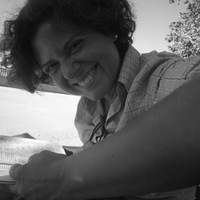Rosa Maria Cucco
Regione Siciliana, Soprintendenza BB.CC.AA. di Palermo, Department Member
- Ceramologia, topografia e archeologia del paesaggio, Archeologia, Archeologia classica Topografia Urbanistica Magna Grecia Sicilia antica, Scavi Archeologici, Landscape Archaeology, Archaeology, and 33 moreClassical Archaeology, Ancient Topography (Archaeology), Roman Archaeology, Ville romane, Archeologia Romana, Pottery (Archaeology), Sicily, Late Roman Archaeology, Mediterranean archaeology, Ancient Sicily, Greek Archaeology, Beni Culturali, Medieval Archaeology, Archeologia Siciliana, Late Antique Archaeology, Archeologia medievale, Medieval Sicily, Phoenician Punic Archaeology, Early Medieval Archaeology, Landscape, Greek Sicily, Cultural Landscapes, Archaeological Prospection, Preistoria e protostoria, Archeologia Classica, Archeologia Tardoantica E Paleocristiana, Urban archaeology, Greek Pottery, Archeologia Postmedievale, Roman Villae, Funerary Archaeology, Ceramic Analysis (Archaeology), and Siciliaedit
- Archeologa per passione e professioneedit
Research Interests:
The return to Carini of the 'Galati' mosaic, found in 1883 in the contrada San Nicola, the site of numerous archaeological discoveries during the 19 th century, as reported by the local and of the time scholars, has contributed to the... more
The return to Carini of the 'Galati' mosaic, found in 1883 in the contrada San Nicola, the site of numerous archaeological discoveries during the 19 th century, as reported by the local and of the time scholars, has contributed to the resumption of systematic archaeological investigations at the site, which can be identified with the statio of Hykkara, mentioned in the Itinerarium Antonini. A revision and re-reading of literary sources and historical cartography has provided food for thought and interpretation on the territorial layout of the late-antique and Byzantine settlement and on the evolution of settlement dynamics and the road network in the transition to the Islamic and Norman periods. The information on monumental findings and infrastructures, deduced from the learned tradition on the site, if adequately contextualised and verified through focused investigations, will increase current knowledge on the settlement of San Nicola, which, also due to its connection with the early Christian catacombs of Villagrazia di Carini, can be considered one of the most important archaeological sites in Sicily.
Research Interests:
Mount Alburchia (969,8 m high), a well recognizable relief in the southern sourroundings of the town of Gangi, was probably inhabited from archaic to the Late Antique (IV-V AD). To this later settlement are referred the stone walls and... more
Mount Alburchia (969,8 m high), a well recognizable relief in the southern sourroundings of the town of Gangi, was probably inhabited from archaic to the Late Antique (IV-V AD). To this later settlement are referred the stone walls and the finds unearthed by Vincenzo Tusa's excavations on the Mount, in 1958. There are two necropolis, one of them used in the period between the Classical and the Archaic Age (VII-V BC), while the other of the Hellenistic period (IV-III BC). The latter, located along a path from " case Salerno " to the Mount, was probably connected to the cult of the deads as heroes, inside niches carved the rock (aediculae), some monumental, located on the northern steep slop of Mount Alburchia. All of them were completely unearthed during the excavation campain carried on, between 2014 and 2015, from the Soprintendenza BB.CC.AA. of Palermo, in collaboration with Santo Ferraro. This sacred complex near Gangi, frequented during Hellenistic and Roman period, has several direct comparisons with several other Sicilian sites.
